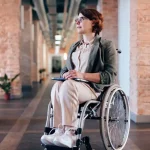Turning a Patient While Saving Your Back
Turning a patient in bed is important for a patient’s comfort and is a task that is done often by caregivers both at home or in another facility.
Anyone who spends long periods in bed may develop pressure sores, blood clots or other medical problems.
Turning a patient in bed is important for blood circulation to all parts of the body, so it is recommended that patients be turned every two hours during the daytime.
If a patient has pressure sores, or bedsores, then turning may be indicated even more often.
How can a caregiver avoid hurting her back while turning a patient?
A draw sheet or turning sheet is a great help with this task. A draw sheet is simply an ordinary flat bed sheet folded up and placed under the patient.
The draw sheet helps when lifting, moving or turning a patient. It also helps a caregiver avoid bruising or tearing a patient’s skin when grasping their arms.
It is helpful to have two people turning a patient, but it can be done by just one person who can do the tasks of two people in turning.
Steps to a Safe Turn
- First, tell the patient what you are going to do. They may be able to help you. Stand on the side that you are going to turn towards.
Having the patient turn their head toward you will cause their body to move in that direction and will help them understand what is going on.
If you have a partner to help, he may stand on the opposite side. - If you are using a bed which can be raised or lowered, then make the bed flat and move it to the level that is comfortable for you to reach, so you will not be straining your back to reach.
- If you are using a bed with a rail, lower the rail on the side you are standing near. Make sure the patient cannot roll off on either side.
- If you do not have a rail on the opposite side, then ask your partner to stand behind the patient on the opposite side so the patient cannot roll off. Or move the bed against a wall on the opposite side so she cannot roll off.
- Position the patient’s arms so they are crossed over his chest and are not trapped under the body. You and your helpers will face the person on one side of the bed.
Put a pillow between the person’s knees. You and other helpers should grasp the edge of the draw-sheet. Roll the edge of the draw-sheet you are holding close to the person you are turning.
On the count of 3, you pull the draw-sheet toward you. Keep your movements smooth. You and your support staff should switch sides of the bed. Each helper will reach over the person to grasp the rolled end of the draw-sheet.
On the count of 3, pull the rolled side of the draw-sheet so the person rolls toward you. - This is called a logroll turn.
Check that the patient’s ankles, knees, and elbows are not stacked onto each other after the patient has turned. Bend the knee of the leg that is not touching the bed.
Place a pillow between the person’s knees. Place pillows or cushions along the person’s back to keep him in position. A pillow under the arm not touching the bed can also help keep the body aligned.
Positioning and Comfort
If you need to turn a patient, always check to see that their head and neck are in a neutral position, not jutting forward, back, or to the side. Bring the bed back to a relaxed posture with the side rails raised.
Ask the patient how they feel to make sure they are at ease. Whenever you feel the need, place a pillow or two between your knees and behind your back.
Check the sheets to see that they are not tangled and the covers are arranged to suit the patient.
A modification of the turning procedure can be made for patients who are capable of grasping the arm rail to help themselves turn while you assist on the opposite side by slowly pulling the draw sheet toward the opposite side of the bed.
The patient will roll toward the rail using this method.
Using a draw sheet will save your back and be much more comfortable for the patient.
Finishing up
Turning a patient in bed is of paramount importance for caregivers if they want to keep the patient comfortable, and ward off any medical hassles such as bedsores or thrombosis.
Employing a draw sheet with a logroll turn and adhering to correct positioning and comfort techniques are great ways to execute turning patients without injuring oneself.
Merely making sure you chat with the patient, use equipment correctly and have ample personnel to help makes this process flow smoothly and secure.

